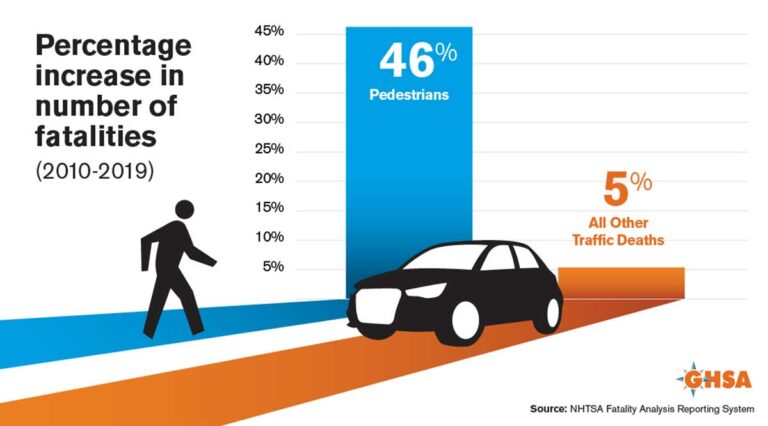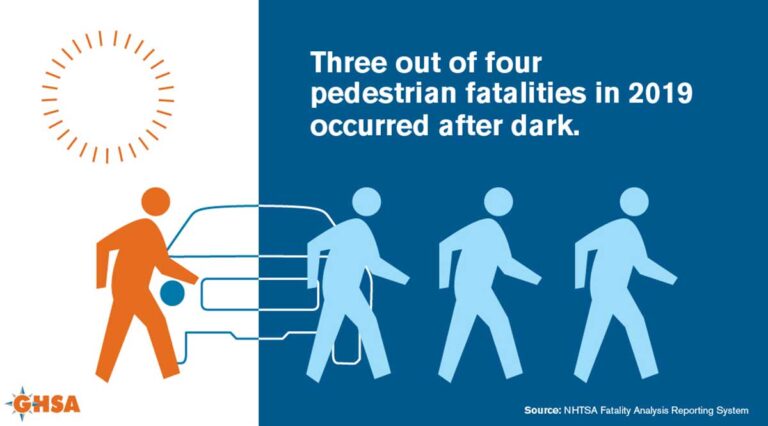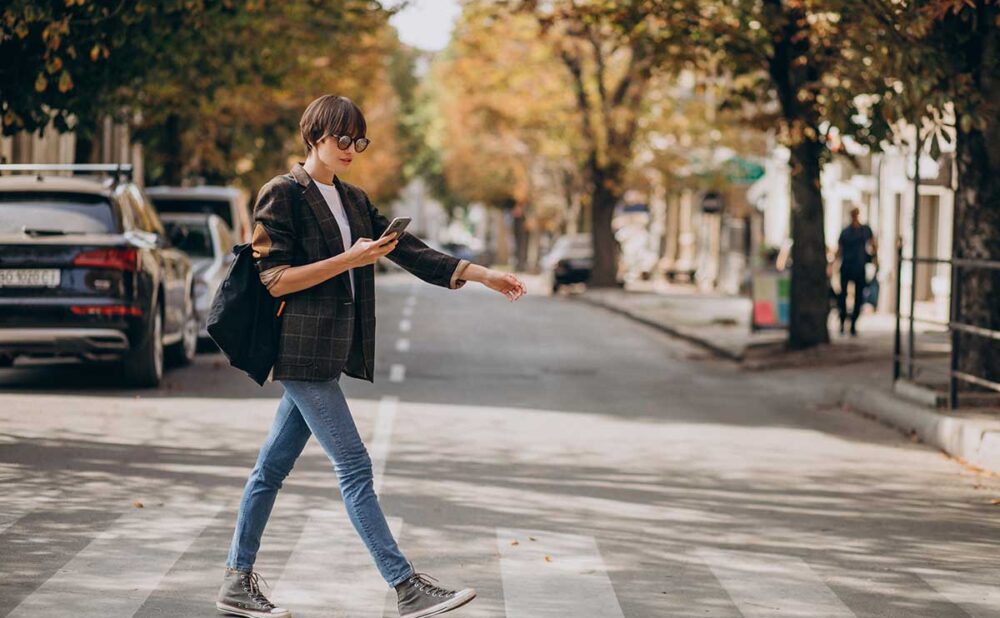Pedestrian Safety in Georgia: A Rising Danger
As more people embrace walking, jogging, and cycling as viable modes of transportation, the need for pedestrian safety has become increasingly critical. These activities not only promote physical fitness but also contribute to financial savings, alleviate traffic-related stress, and benefit the environment by minimizing reliance on fossil fuels. However, with the rise in smartphone usage and other electronic devices, alongside escalating traffic volumes—particularly within the Atlanta region—there is a growing presence of distracted drivers. Such distracted driving incidents pose a substantial threat to pedestrian safety in Georgia.
In urban areas like Metro Atlanta, the challenge of pedestrian safety has become increasingly pressing. With sprawling neighborhoods and a reliance on vehicles, walking in the city can be both invigorating and perilous. Metro Atlanta has a reputation for lacking a pedestrian-friendly infrastructure. The considerable distances separating various neighborhoods often necessitate the use of cars or public transit. Despite this, pedestrians frequently populate the city’s streets. Although walking through Midtown can offer a pleasant experience, it also poses significant risks.
The Alarming Statistics
Recent crash statistics reveal a troubling trend: pedestrian fatalities have surged in recent years, prompting a closer examination of the factors contributing to this alarming rise in pedestrian accidents. Between 2010 and 2019, pedestrian deaths in the United States escalated by nearly 45%, culminating in a staggering 6,412 fatalities in 2019 alone. Contrary to expectations, the onset of the COVID-19 pandemic in 2020 did not result in a decline in these tragic incidents. Instead, preliminary data suggests that the number of pedestrian deaths rose to approximately 6,721 that year. This translates to an increase in pedestrian fatalities per billion vehicle miles traveled from 1.8 in 2019 to 2.2 in 2020—a concerning rise of over 20%.
Interestingly, a small number of states account for a significant portion of these fatalities, with seven states alone representing over half of the total. The states with the highest pedestrian death tolls include:
- California (1,026 deaths)
- Florida (729 deaths)
- Texas (723 deaths)
- Georgia (273 deaths)
- North Carolina (263 deaths)
- New York (235 deaths)
- Arizona (225 deaths)
This data can be puzzling at first glance. With fewer vehicles on the roads during the pandemic, one might expect a reduction in pedestrian accidents. However, two primary factors appear to be at play: the increased prevalence of larger vehicles and a rise in reckless driving behavior.

Regardless of the circumstances, if you or someone you care about has been injured or killed in a vehicle collision, there are legal avenues available to you. At The Jewkes Firm, our knowledgeable pedestrian accident attorneys in Atlanta understand the profound impact these incidents can have. You can count on our legal team to help you every step of the way, from arranging for medical care to negotiating with insurance providers, and if required, filing a lawsuit against them.
Reach out to us at (770) 771-5130 or connect with us online for a complimentary consultation without any obligation. Our team is available around the clock to respond to your inquiries, and you won’t incur any fees unless we achieve a favorable outcome on your behalf.

GEORGIA PERSONAL INJURY LAWYER NEAR ME
How Vehicle Size Impacts Pedestrian Safety
In recent decades, there has been a marked transition in the automotive market toward larger vehicles, such as SUVs and trucks. In 2021, nearly all states reported that the best-selling vehicles were these larger models, with sedans trailing far behind. While these vehicles offer advantages such as more space and perceived safety, their size significantly impacts pedestrian safety.
Larger vehicles present unique dangers. Their weight and dimensions make them harder to control, particularly at higher speeds. Additionally, the increased stopping distance required by larger vehicles exacerbates the risk of accidents. Height also plays a role; taller vehicles can obscure the driver’s view of pedestrians, increasing the likelihood of collisions. The injuries sustained in such accidents tend to be more severe. Where a sedan might primarily cause leg injuries, larger vehicles often result in catastrophic injuries to the head, neck, or torso.
Reckless Driving Trends on Empty Roads
The second contributing factor to the rise in pedestrian fatalities is the increase in reckless driving behavior. During the early stages of the pandemic, with fewer cars on the road, many drivers engaged in riskier driving practices, such as excessive speeding. Law enforcement’s hesitance to engage in routine traffic stops during this time further contributed to this trend.
Psychologically, the pandemic has influenced driver behavior. Heightened stress and frustration levels have led to an increase in aggressive driving. Experts note that drivers have experienced “salience saturation,” where constant exposure to pandemic-related fear has desensitized them to other dangers on the road. This phenomenon, combined with social isolation, can impair drivers’ risk assessment abilities, resulting in a disregard for traffic laws.

Key Tips for Pedestrian Safety
Despite the challenges posed by larger vehicles and reckless driving, pedestrians can take steps to enhance their safety while navigating Georgia’s streets. Here are some practical tips from the National Highway Traffic Safety Administration:
- Stay Alert. Always be aware of your surroundings, including vehicles and other pedestrians.
- Use Designated Crosswalks. Whenever possible, cross streets at marked crosswalks and obey traffic signals.
- Make Eye Contact. Establish visual communication with drivers before crossing to ensure they see you.
- Avoid Distractions. Refrain from using mobile devices or wearing headphones while walking, as these can divert your attention.
- Wear Visible Clothing. Opt for bright or reflective clothing, especially in low-light conditions, to enhance visibility.
- Avoid Impairments. Refrain from consuming alcohol or drugs before walking, as they can disrupt judgment and focus.
- Follow Traffic Laws. Always adhere to pedestrian rules and signals to promote a safe environment for everyone.
Pedestrians in Georgia should be aware of critical safety precautions to enhance their protection while navigating roadways. Pedestrians should follow these guidelines to increase awareness and minimize the risk of accidents. Always remain vigilant, use designated crosswalks, and adhere to traffic signals.
Pedestrian Safety for Children
The National Highway Traffic Safety Administration (NHTSA) provides valuable resources for educating children on pedestrian safety. The NHTSA’s pamphlet titled “A Kid’s Guide to Safe Walking” outlines the following key points to discuss with your child:
- Always stop at the curb or the edge of the road if there is no curb present.
- Before entering the street, stop and check for cars by looking left, then right, and once more to the left.
- When a vehicle approaches, please allow it to pass before proceeding. Afterward, check again—left, right, left—until it is clear of traffic.
- When crossing near a parked car, ensure that no driver is inside and that the engine is off.
- Proceed to the edge of the roadway and again look left-right-left for oncoming vehicles.
- Only cross when there are no cars approaching; remember to walk—not run—while continuing to observe left-right-left during your crossing.
Additionally, if your child utilizes bus transportation, please remind them of these important bus safety practices:
- Wait until after the bus has extended its stop sign before attempting to cross the street; always look both ways beforehand.
- Maintain a distance of five steps from the curb while waiting for the bus.
- Ensure that you board only when the bus has come to a complete stop and you receive a signal from the driver.
- Upon exiting, wait until the bus has completely stopped before checking left-right-left for any incoming vehicles before crossing.
Injured In A Pedestrian Accident? Contact Us For A Free Consultation
Injured In A Pedestrian Accident?
Navigating Georgia’s Pedestrian Laws
What should I do if I’m struck by a vehicle while crossing a roadway without a designated crosswalk?
It’s crucial to familiarize yourself with Georgia’s regulations regarding pedestrians who navigate roads lacking crosswalks.
What actions should I take if I’m caught in the middle of a crosswalk when the traffic signal changes?
Pedestrians must exercise caution even when granted the right of way within crosswalks. It is essential to remain vigilant and ensure safety before entering a crosswalk.
Georgia legislation mandates that all vehicle operators must take appropriate precautions to prevent striking pedestrians. Additionally, it stipulates that pedestrians should utilize crosswalks when available.
How should I proceed if a crosswalk is not available?
Per Georgia statute 40-1-1.(10), a “Crosswalk” is defined as:
- The area at an intersection between sidewalk lines.
- Any marked portion for pedestrian crossing.
Unmarked areas at corners can also be crosswalks. Under Georgia law, drivers must yield to pedestrians in crosswalks. Always exercise caution when entering a crosswalk, especially as traffic signals change.
How might being struck at night while dressed in dark clothing influence liability?
Let’s examine several factors to address this question:
- Were you in a brightly lit location?
- Was there a designated crosswalk present, and did you utilize it?
- Were you at an intersection?
Georgia’s legislation assigns accountability to both pedestrians and drivers in preventing accidents, requiring both groups to act with caution to avert collisions.
State law requires pedestrians to use sidewalks when available.

What Defines a Pedestrian in Georgia?
A pedestrian refers to an individual who travels on foot, typically within urban areas or public spaces. This term encompasses anyone walking, whether for leisure, commuting, or recreational activities. Pedestrians are key participants in road traffic and play a significant role in urban mobility and safety considerations.
Georgia Code 40-6-96 defines a “pedestrian” encompasses “any person on foot,” encompassing individuals engaged in various forms of movement such as walking, jogging, or standing. Everyone has been a pedestrian at some point, whether traversing short distances or covering several miles. Regrettably, pedestrian fatalities remain alarmingly high in Georgia and across the United States. With pedestrian fatalities on the rise—up by 50% nationally in recent years—it’s essential to recognize the shared responsibility between pedestrians and drivers in preventing accidents.
Experts frequently attribute this rise to the prevalence of mobile devices. Many pedestrians are struck by vehicles while distractedly using their phones as they cross streets. Conversely, there are numerous cases where collisions occur because drivers themselves are not paying attention to the road due to their own mobile device usage.
Understanding Georgia’s Pedestrian Laws in Simple Terms
In 1995, the Georgia legislature revised the laws governing crosswalks, mandating that drivers must “stop and stay stopped” for pedestrians. Below is a summary of the current regulations regarding pedestrian right of way in Georgia:
Section 40-6-91. Right of Way in Crosswalks
Vehicles must yield to pedestrians already in or nearing a crosswalk. It’s essential for pedestrians to exercise caution when crossing. Therefore, if one driver stops for pedestrians, others must also stop. In this situation, pedestrians retain the right of way.
Section 40-6-92 – Crossing Roadway Elsewhere than at Crosswalk
Unless already in the roadway, pedestrians must give way to vehicles. It is advisable to utilize intersections when crossing if no crosswalk is available. When alternate crossing methods such as pedestrian bridges or tunnels exist, pedestrians are expected to utilize these facilities for safe crossing.
Pedestrians must only cross at designated marked crosswalks located between neighboring intersections. Diagonal crossing is not permitted. Instead, ensure that your route consists of two separate crossings.
Section 40-6-22. Pedestrian-Control Signals
When special pedestrian-control signals are present, displaying either the words WALK or DON’T WALK, or corresponding symbols that direct pedestrian movement, they shall convey the following information:
- Pedestrians must adhere to the WALK signal facing them. Drivers must ensure that pedestrians have cleared the road before proceeding.
- The presence of a flashing or steady DON’T WALK indicates that no new crossings should commence; nonetheless, those already in motion within the crosswalk retain their right to finish crossing safely.
Compliance with pedestrian signals is mandatory for both pedestrians and drivers.
Other Georgia Pedestrian Regulations
Section 40-1-1.(57) Definition of a Sidewalk
“Sidewalk” means that portion of a street between the curb lines, or the lateral lines of a railway, and the adjacent property lines, intended for use by pedestrians.
Section 40-1-1.(22) Definition of an Intersection
An “intersection” refers to the area created by the extension of adjacent curb lines or road edges where two roads converge and where potential vehicle conflict may occur. If a highway has two roadways at least 30 feet apart, each crossing by an intersecting highway counts as a separate intersection. This applies similarly if the intersecting highway also has two roadways. The meeting of an alley with a street or highway does not qualify as an intersection.
Summary of Pedestrian Rights
Understanding pedestrian rights and responsibilities in Georgia is essential for safety. Here’s a summary:
- Right of Way. Pedestrians typically have the right of way at designated crosswalks. Drivers must yield to pedestrians who are already in the crosswalk or approaching from within one lane.
- Crossing Without a Crosswalk. If crossing at a location without a designated crosswalk, pedestrians must yield to vehicles unless they have already entered the roadway.
- Light Changes. If you are in a crosswalk when the signal changes, you still have the right to complete your crossing safely.
Legal Support After a Pedestrian Injury
The rising danger of pedestrian accidents in Metro Atlanta underscores the urgent need for enhanced awareness and pedestrian safety measures. By understanding the factors contributing to these accidents and adopting safe walking practices, pedestrians can navigate their environment more securely. Additionally, if you or someone you know has been affected by such an incident, it is crucial to understand your legal rights. Many insurance companies may attempt to minimize their liability, making it essential to seek expert legal guidance.
The attorneys at The Jewkes Firm are prepared to assist you in obtaining compensation after a pedestrian accident. Contact us today at (770) 771-5130 for a free consultation.

GEORGIA PERSONAL INJURY LAWYER NEAR ME
Understanding Liability After an Accident
Pedestrian accidents can lead to complex legal situations. Liability can be impacted by various factors. These include the visibility conditions, the use of crosswalks, and the pedestrian’s behavior before the incident. Georgia law requires both pedestrians and drivers to exercise due care. In incidents where a vehicle collides with a pedestrian, liability typically rests with the driver.
Contact a Local Pedestrian Accident Attorney
Increasing our walking habits is beneficial for our health, finances, and communities. However, both pedestrians and drivers must remain vigilant, particularly in areas with heavy traffic. While Georgia law provides certain protections for pedestrians, individuals must ultimately take responsibility for their own safety.
If you or someone close to you has sustained injuries in a pedestrian accident in Georgia, navigating the legal landscape can be challenging. Establishing liability and pursuing compensation from the responsible party or their insurance provider may involve significant effort. At The Jewkes Firm, our team of Atlanta auto accident attorneys possesses comprehensive knowledge of Georgia’s laws regarding pedestrian right-of-way and the shared duty of care among all residents.
Have Questions?
Reach out to The Jewkes Firm at (770) 771-5130 for guidance. Your first consultation is free.
FindLaw.com – Georgia Code Title 40. Motor Vehicles and Traffic § 40-1-1 – last updated March 28, 2024 | https://codes.findlaw.com/ga/title-40-motor-vehicles-and-traffic/ga-code-sect-40-1-1.html
FindLaw.com – Georgia Code Title 40. Motor Vehicles and Traffic § 40-6-144 – last updated March 28, 2024 | https://codes.findlaw.com/ga/title-40-motor-vehicles-and-traffic/ga-code-sect-40-6-144/
FindLaw.com – Georgia Code Title 40. Motor Vehicles and Traffic § 40-6-203 – last updated March 28, 2024 | https://codes.findlaw.com/ga/title-40-motor-vehicles-and-traffic/ga-code-sect-40-6-203.html
FindLaw.com – Georgia Code Title 40. Motor Vehicles and Traffic § 40-6-96 – last updated March 28, 2024 | https://codes.findlaw.com/ga/title-40-motor-vehicles-and-traffic/ga-code-sect-40-6-96.html
FindLaw.com – Georgia Code Title 40. Motor Vehicles and Traffic § 40-6-91 – last updated March 28, 2024 | https://codes.findlaw.com/ga/title-40-motor-vehicles-and-traffic/ga-code-sect-40-6-91.html
FindLaw.com – Georgia Code Title 40. Motor Vehicles and Traffic § 40-6-92 – last updated March 28, 2024 | https://codes.findlaw.com/ga/title-40-motor-vehicles-and-traffic/ga-code-sect-40-6-92.html
FindLaw.com – Georgia Code Title 40. Motor Vehicles and Traffic § 40-6-22 – last updated March 28, 2024 | https://codes.findlaw.com/ga/title-40-motor-vehicles-and-traffic/ga-code-sect-40-6-22.html





